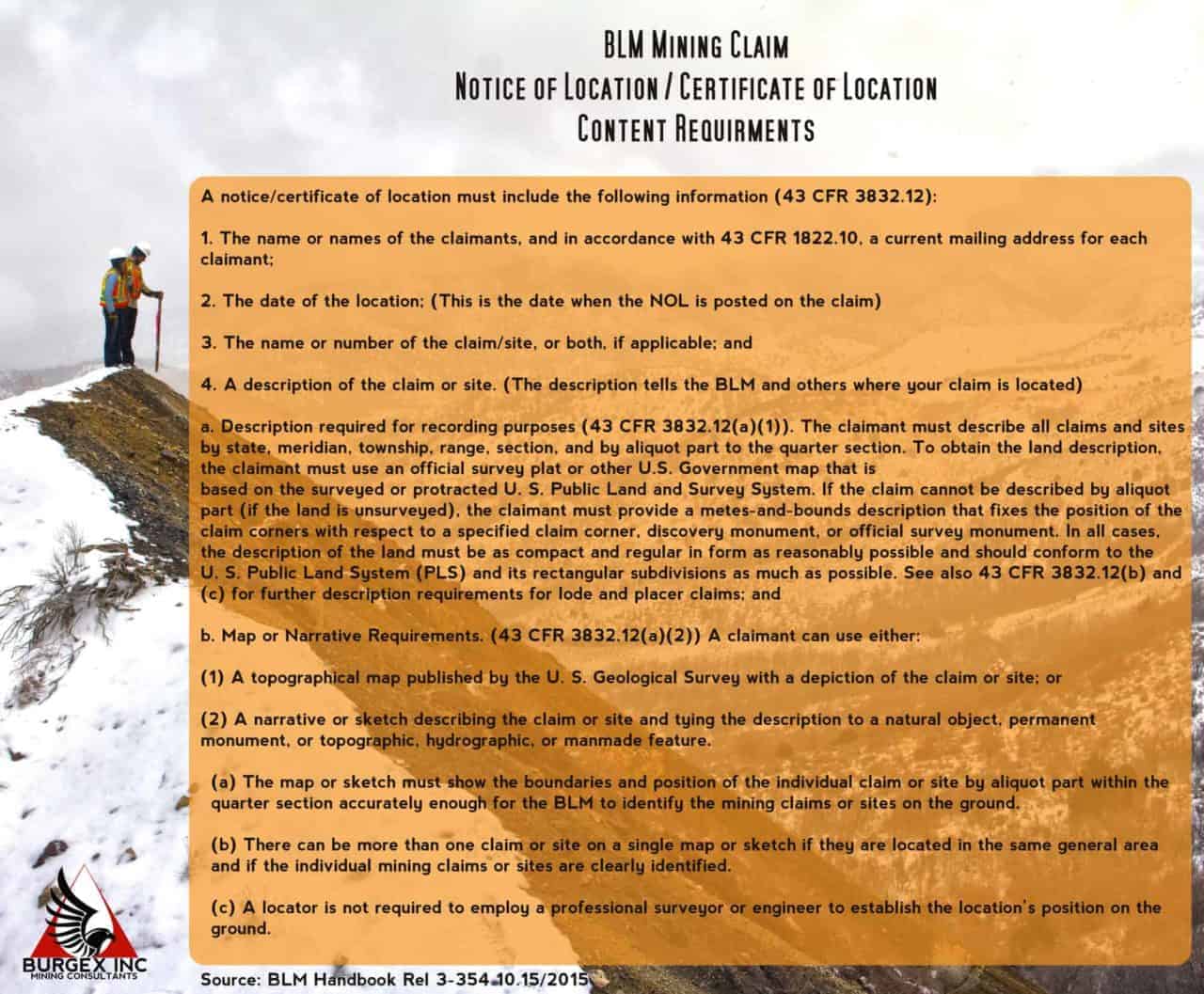Drafting a new notice/certificate of location (NOL/COL) for a lode or placer claim can be intimidating. Most of the information available online is scattered and can be confusing or over-technical. The BLM mining claim notice of location requirements listed below were taken directly from the BLM Handbook (Rel 3-354: 10/15/2015). You can use these requirements with confidence knowing that they are from the same handbook that the BLM uses to guide checking the claims when you file them.
Feel free to download and print out these BLM mining claim notice of location requirements for future reference when drafting your next batch of NOLs. These notice/certificate content requirements are part of a new series of articles we are posting to help clarify and simplify understanding of the BLM mine claim location and filing process.
Use this handy chart to double check your notices and certificates of location before filing them with the BLM.You can download a high resolution copy of this BLM mining claim notice of location requirements poster here.
BLM Mining Claim Notice of Location Requirements: Basic Requirements
A notice/certificate of location must include the following information (43 CFR 3832.12):
1. The name or names of the claimants, and in accordance with 43 CFR 1822.10, a current mailing address for each claimant;
Remember that a mine claim can have multiple claimants, but each claimant needs to meet the qualifications to own a claim.
2. The date of the location;
This is the date when the NOL is posted on the claim in a conspicuous place, such as on your location/discovery monument.
3. The name or number of the claim/site, or both, if applicable; and
This is the fun part, come up with whatever claim name/number you want.
BLM Mining Claim Notice of Location Requirements: Description Requirements
4. A description of the claim or site.
This is the most detailed part of the process. You need to make sure your description is clear and accurate.
a. Description required for recording purposes (43 CFR 3832.12(a)(1)). The claimant must describe all claims and sites by state, meridian, township, range, section, and by aliquot part to the quarter section. To obtain the land description, the claimant must use an official survey plat or other U.S. Government map that is based on the surveyed or protracted U. S. Public Land and Survey System. If the claim cannot be described by aliquot part (if the land is unsurveyed), the claimant must provide a metes-and-bounds description that fixes the position of the claim corners with respect to a specified claim corner, discovery monument, or official survey monument. In all cases, the description of the land must be as compact and regular in form as reasonably possible and should conform to the U. S. Public Land System and its rectangular subdivisions as much as possible. See also 43 CFR 3832.12(b) and (c) for further description requirements for lode and placer claims; and
Use the public land and survey system (PLSS) whenever possible. If the land is unsurveyed, be sure to provide an accurate description of metes-and-bounds that ties the claim monument and corners to a permanent monument.
b. Map or Narrative Requirements. (43 CFR 3832.12(a)(2)) A claimant can use either:
(1) A topographical map published by the U. S. Geological Survey with a depiction of the claim or site; or
This is usually the best way to map our your claim(s). You can find free USGS topo maps for download in several locations online. The USGS Topo Map Locator is a great source that is easy to use.
(2) A narrative or sketch describing the claim or site and tying the description to a natural object, permanent monument, or topographic, hydrographic, or manmade feature.
If you cannot find a suitable topo map, this is an alternative that the BLM accepts IF your map or sketch meets the requirements listed below.
(a) The map or sketch must show the boundaries and position of the individual claim or site by aliquot part within the quarter section accurately enough for the BLM to identify the mining claims or sites on the ground.
(b) There can be more than one claim or site on a single map or sketch if they are located in the same general area and if the individual mining claims or sites are clearly identified.
(c) A locator is not required to employ a professional surveyor or engineer to establish the location’s position on the ground.
While you are not required to hire a professional to complete this work, it is useful to do so if you have a large or important project and want to ensure accuracy.
Following these simple BLM mining claim notice of location requirements will ensure that your next notices of location are accurate and complete. While there are many other factors that determine if your mine claim is valid, having a complete notice of location is a great start.
Burgex Inc. provides fast and accurate notice and certificate of location drafting and filing services. We understand the BLM mining claim notice of location requirements and have experience drafting and filing notices of location throughout the Western United States and Alaska. We also provide affordable consulting services to check your paperwork and make sure that you are sufficiently meeting all the BLM Mining Claim Notice of Location Requirements. Contact us today for a free estimate!

